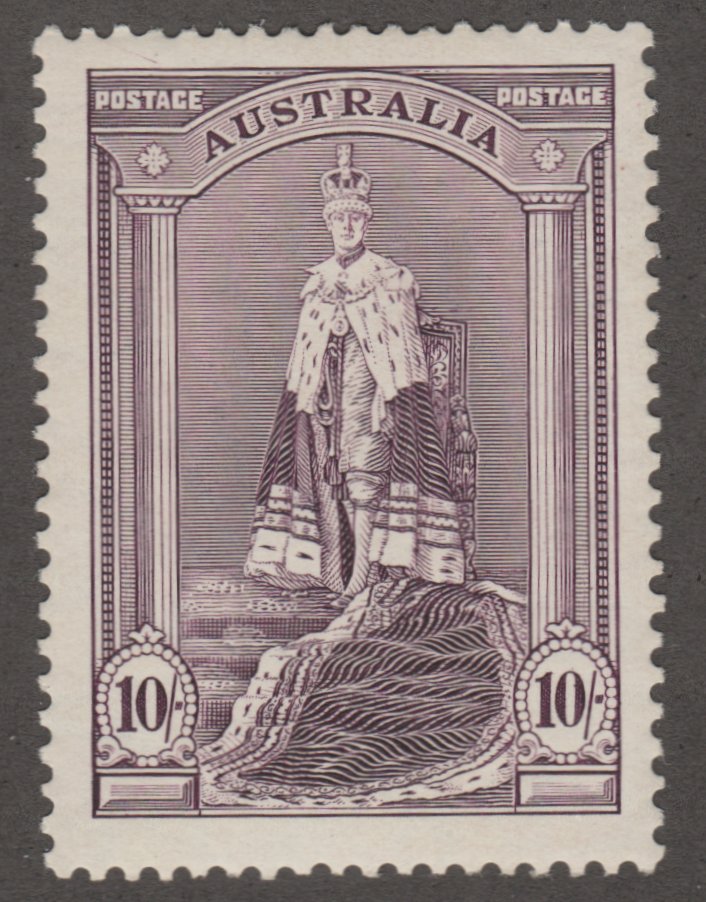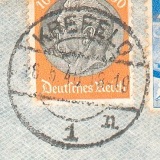
Discussion - Member to Member Sales - Research Center

Discussion - Member to Member Sales - Research Center

Thanks.
Peter



Login to Like
this post
I always thought that, regarding centering, the Extremely Fine, Very Fine, Fine, Good (cutting into design), and Perf Error or misperf (darn near bisecting the design) were all that is required, and most people understood the differences (although not all are consistent with their classifications when grading their own items).
Offset, although the word may seem appropriate in the context of identifying a shift, should in philately (INMHO) be reserved for the printing technique, or the description of the fault when stamps with wet ink are stacked and the image is transferred to the gum side of the stamps on top.

Login to Like
this post

10:25:15am
Doug,
I think you and Peter are discussing apples and oranges here. He is referring to the vignette position on bi-colored (mostly) stamps relative to the surrounding design, and you are referencing terms related to the centering of the entire design relating to its borders (perforations, edge, etc.)
Peter,
My favorite stamp for exploration of this avenue of discussion is US Scott # C3. Two examples (my terminology may not be exactly correct):
fast plane: Â Â Â Â Â
               
landing plane: Â Â Â Â Â
               

Login to Like
this post
Well now, that's embarrassing! Would help if I read the post better! Sorry, Peter. 

Login to Like
this post
No problem, Doug.
Bobby, those are great descriptions! 

Login to Like
this post
For C3, I thought it was fast plane, slow plane, high plane, low plane, but that only describes one issue. I always just called it poor registration, and then describe (e.g. poor registration - vignette to left in frame). We discussed something similar several years ago at StampWants where a stamp was graded 98 by PSE because the frame was beautifully centered, but the vignette was way out of registration and we thought that was odd that registration of the vignette didn't seem to matter. I think it was C87 that we discussed way back then. Doug may remember.
Lars

Login to Like
this post

04:39:21pm
Lars,
Told you I was unsure of the terminology, and thanks for the clarification. Maybe the vignette shift is due to poor registration, but if severe enough, it affects the price positively, sometimes very dramatically so. This is true on C3, as well as the (1904?) Transportation issue. I also dabble in EFOs (in which category these type things are usually classified), more for the oddity than anything else.
Fun stamps! Ain't it what it is all about? (Or is that the Hokey Pokey?) 

Login to Like
this post
"Maybe the vignette shift is due to poor registration, but if severe enough, it affects the price positively, sometimes very dramatically so."
Absolutely! There are many examples where the stamp is so defective it becomes an EFO. Something similar happened a lot with US 1461 when a color shift made it look like one of the toboggan riders was jumping out of the sled!

Lars

Login to Like
this post

05:11:23pm
" .... Maybe the vignette shift is due to poor registration, but if severe enough, it affects the price positively, sometimes very dramatically so." ...."
I seem to recall that the Curtiss Jenny was printed first followed by the frame.
If that were true, it would be the frame that was mis-registersd. The perfs would have been added last based on the guide lines that are printed with the frame's margin.
Had the Frame gone first the guide lines could have been used to accurately center the aircraft or the beacon.
Unfortunately all these minor factors became important to those "investors" who wanted perfect examples so that they would not encounter negative comments from prospective buyers that would give then a reason to demand a lower offered selling price.
I think collectors might appreciate perfectly centered examples of their stamps but also are amused by the inadvertent mis-registrations that add some character to their rows and rows of stamps.
Another thought (speculatiom) about centering is that if the center of the Jenny or the Beacon were spaced as little as 0.2mm too wide, a miniscule error for the technology of the day, and the stamps printed in press sheets of 400 copies with a gutter space so that panes of 100 could be created, the printer could have perfectly aligned one column and then each column to the side would have an increased mis-registration to the side. Five columns away and the offset would be 1.0 mm and easily visible with the naked eye. The same effect would occur if the space betwixt the center of the images were 0.2mm too close.
It must have been quite a challenge to get it right or al;most right to often.

Login to Like
this post
Charlie, you are so right, but they could have EXACTLY lined everything up and it wouldn't work out because the paper shrinkage in the wet printing process prior to 1960 or so was not uniform across the sheet (flat plate) or roll (rotary).

Login to Like
this post

12:16:37pm
Shrinkage is often an ongoing problem.

Login to Like
this post
06:04:16am
I've seen sellers describe stamps with the central design off-center, in various ways: Offset, off-center, shifted, misprinted, off-printed, printing error, overlapped design, ... is there an acceptable term to describe this? I use as an example two stamps that Bobby should like to see especially. The one on the top is shifted to the left so the center overlaps with the left design edge; the one below it is shifted right.
Thanks.
Peter



Login to Like
this post

re: How do you describe off-center printing on a stamp?
I always thought that, regarding centering, the Extremely Fine, Very Fine, Fine, Good (cutting into design), and Perf Error or misperf (darn near bisecting the design) were all that is required, and most people understood the differences (although not all are consistent with their classifications when grading their own items).
Offset, although the word may seem appropriate in the context of identifying a shift, should in philately (INMHO) be reserved for the printing technique, or the description of the fault when stamps with wet ink are stacked and the image is transferred to the gum side of the stamps on top.

Login to Like
this post
They who would give up essential Liberty, to purchase a little temporary Safety, deserve neither Liberty nor Safety. -Benjamin Franklin
25 Jan 2014
10:25:15am
re: How do you describe off-center printing on a stamp?
Doug,
I think you and Peter are discussing apples and oranges here. He is referring to the vignette position on bi-colored (mostly) stamps relative to the surrounding design, and you are referencing terms related to the centering of the entire design relating to its borders (perforations, edge, etc.)
Peter,
My favorite stamp for exploration of this avenue of discussion is US Scott # C3. Two examples (my terminology may not be exactly correct):
fast plane: Â Â Â Â Â
               
landing plane: Â Â Â Â Â
               

Login to Like
this post

re: How do you describe off-center printing on a stamp?
Well now, that's embarrassing! Would help if I read the post better! Sorry, Peter. 

Login to Like
this post
12:53:32pm
re: How do you describe off-center printing on a stamp?
No problem, Doug.
Bobby, those are great descriptions! 

Login to Like
this post

re: How do you describe off-center printing on a stamp?
For C3, I thought it was fast plane, slow plane, high plane, low plane, but that only describes one issue. I always just called it poor registration, and then describe (e.g. poor registration - vignette to left in frame). We discussed something similar several years ago at StampWants where a stamp was graded 98 by PSE because the frame was beautifully centered, but the vignette was way out of registration and we thought that was odd that registration of the vignette didn't seem to matter. I think it was C87 that we discussed way back then. Doug may remember.
Lars

Login to Like
this post
They who would give up essential Liberty, to purchase a little temporary Safety, deserve neither Liberty nor Safety. -Benjamin Franklin
25 Jan 2014
04:39:21pm
re: How do you describe off-center printing on a stamp?
Lars,
Told you I was unsure of the terminology, and thanks for the clarification. Maybe the vignette shift is due to poor registration, but if severe enough, it affects the price positively, sometimes very dramatically so. This is true on C3, as well as the (1904?) Transportation issue. I also dabble in EFOs (in which category these type things are usually classified), more for the oddity than anything else.
Fun stamps! Ain't it what it is all about? (Or is that the Hokey Pokey?) 

Login to Like
this post

re: How do you describe off-center printing on a stamp?
"Maybe the vignette shift is due to poor registration, but if severe enough, it affects the price positively, sometimes very dramatically so."
Absolutely! There are many examples where the stamp is so defective it becomes an EFO. Something similar happened a lot with US 1461 when a color shift made it look like one of the toboggan riders was jumping out of the sled!

Lars

Login to Like
this post
Silence in the face of adversity is the father of complicity and collusion, the first cousins of conspiracy..
27 Jan 2014
05:11:23pm
re: How do you describe off-center printing on a stamp?
" .... Maybe the vignette shift is due to poor registration, but if severe enough, it affects the price positively, sometimes very dramatically so." ...."
I seem to recall that the Curtiss Jenny was printed first followed by the frame.
If that were true, it would be the frame that was mis-registersd. The perfs would have been added last based on the guide lines that are printed with the frame's margin.
Had the Frame gone first the guide lines could have been used to accurately center the aircraft or the beacon.
Unfortunately all these minor factors became important to those "investors" who wanted perfect examples so that they would not encounter negative comments from prospective buyers that would give then a reason to demand a lower offered selling price.
I think collectors might appreciate perfectly centered examples of their stamps but also are amused by the inadvertent mis-registrations that add some character to their rows and rows of stamps.
Another thought (speculatiom) about centering is that if the center of the Jenny or the Beacon were spaced as little as 0.2mm too wide, a miniscule error for the technology of the day, and the stamps printed in press sheets of 400 copies with a gutter space so that panes of 100 could be created, the printer could have perfectly aligned one column and then each column to the side would have an increased mis-registration to the side. Five columns away and the offset would be 1.0 mm and easily visible with the naked eye. The same effect would occur if the space betwixt the center of the images were 0.2mm too close.
It must have been quite a challenge to get it right or al;most right to often.

Login to Like
this post

re: How do you describe off-center printing on a stamp?
Charlie, you are so right, but they could have EXACTLY lined everything up and it wouldn't work out because the paper shrinkage in the wet printing process prior to 1960 or so was not uniform across the sheet (flat plate) or roll (rotary).

Login to Like
this post
Silence in the face of adversity is the father of complicity and collusion, the first cousins of conspiracy..
28 Jan 2014
12:16:37pm
re: How do you describe off-center printing on a stamp?
Shrinkage is often an ongoing problem.

Login to Like
this post

